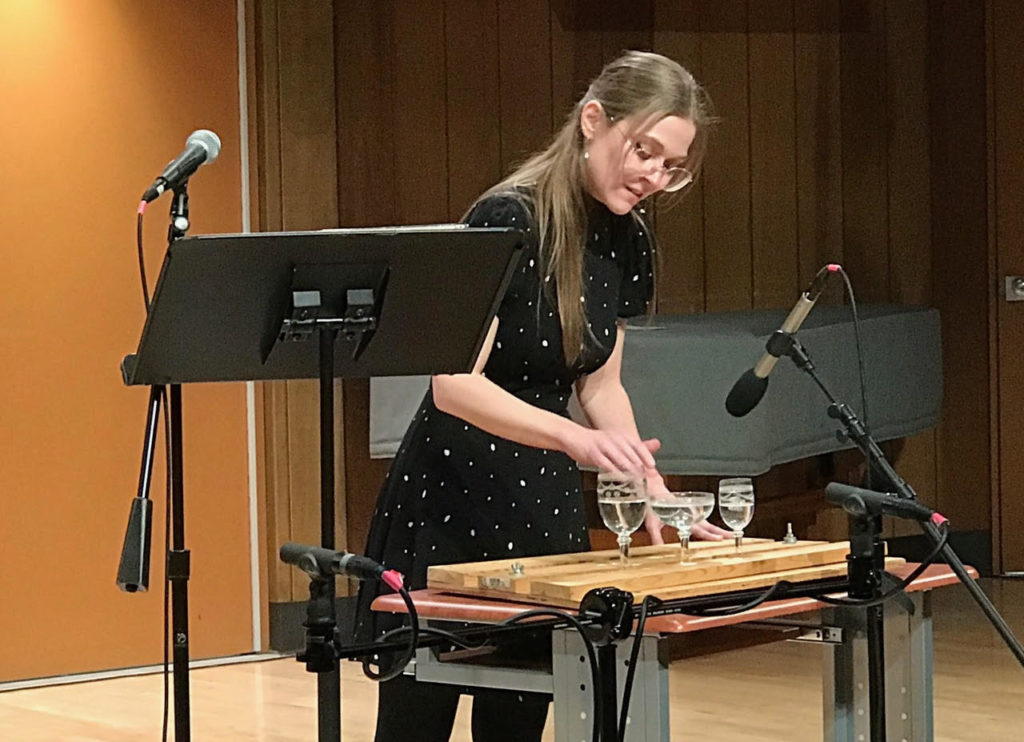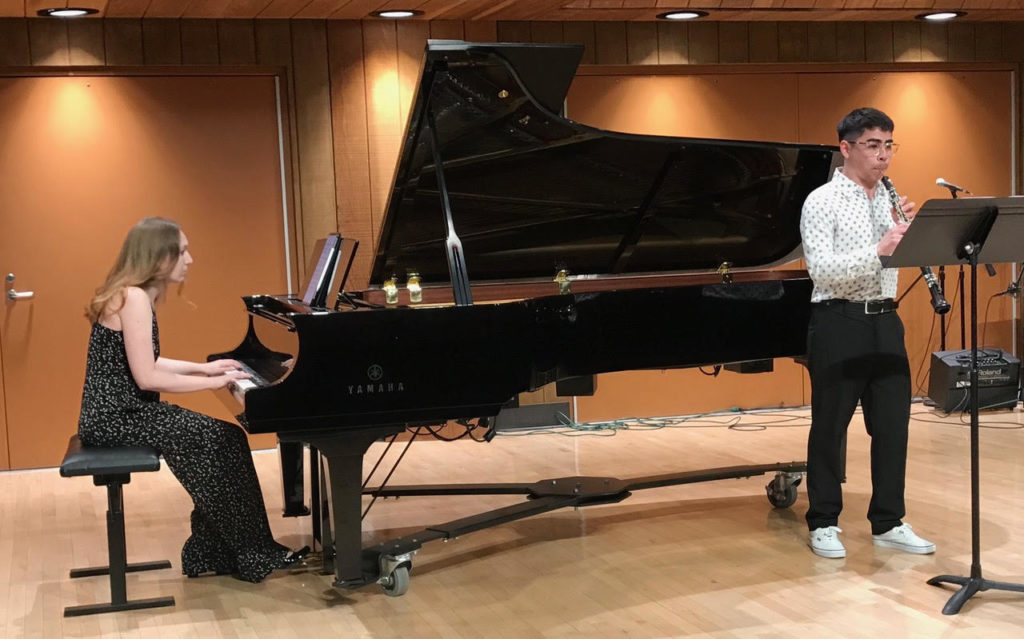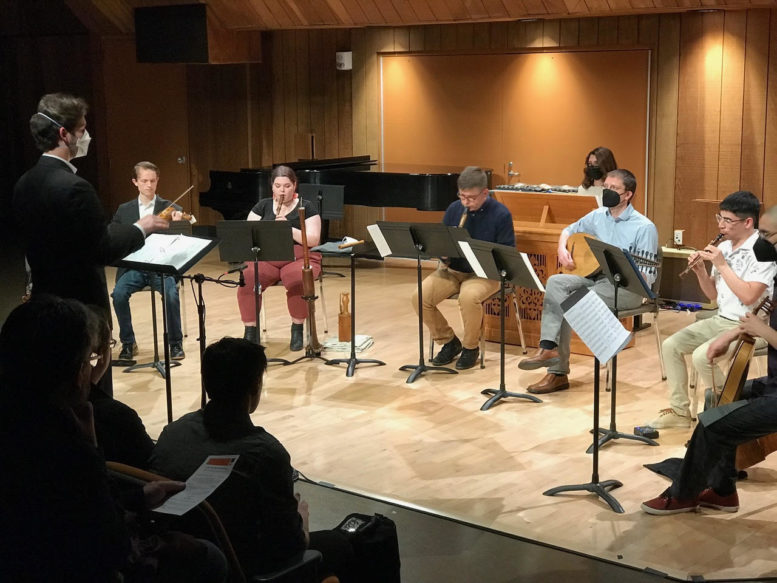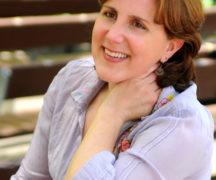By DAVID DUPONT
BG Independent News
The International Conference of Music and Minimalism features plenty of piano and percussion. It also has crumhorn, lute, tenor bombard and baritone rackett, as well as glasses filled with water.
On Sunday morning, there will be butterflies.
Minimalism, a musicalgenre that emerged from the New York City downtown scene in the 1960s, is known for its insistent rhythmic pulse with melodic fragments that repeat, and fold over one another, as they slowly morph.
The eight concerts being presented at the conference being held at BGSU show a far greater range.
Minimalism in that form has become “pretty ubiquitous,” said Ryan Ebright, the BGSU professor of musicology who is the lead organizer of the conference.
The sound and style of the music in its classic form particularly lends itself to film scores, such as Michael Nyman’s music for “The Piano” and Philip Glass’ music for “The Hours.”
But minimalism is more than that. There’s a more experimental branch. “In contrast to the gentle pleasing harmonies of Philip Glass and John Adams, some of this music will have a slightly more aggressive or abrasive approach to minimalism, which is just as gripping.”
And some is more concerned with an idea. Cue the butterflies.
On Sunday at 8:30 a.m. in the courtyard of the Moore Musical Arts Center, the conference will present La Monte Young’s Composition 1960 No. 5. The piece, Ebright explained, involves setting a butterfly or butterflies loose. The piece ends when the last butterfly has left the performance area.

The variety sounds within the genre was evident in Downtown Minimalism, the first of the eight concerts being presented.
The recital opened with “Electric Counterpoint” by Steve Reich performed by guitarist Chris Schoelen. This was textbook minimalism. Written for 16 guitars – 15 of which are recorded – the lines repeat insistently, overlapping, and the lead instrument shifts along the way, flowing smoothly, before moving into a highly syncopated passage.
Schoelen recorded all the parts himself. That’s best, he said, so tone is consistent among the interlocking lines.

Right afterward, his wife and partner in the duo Deux Saisons, Keri Lee Pierson, took the stage to perform a set of solo songs by Meredith Monk.
Ebright singled these out as work many would not place under the rubric of minimalism.
“Not a lot of performers tackle those because these pieces Monk wrote for herself,” he said. “It takes a person with a particular instrument to be able to perform those.”
They require a host of vocal tricks. On the first “Light Songs: Click Song #1 & 2,” Pierson hummed and punctuated with quick clicks. She added these accents while sustaining the humming. In the last song in the set “Our Lady of Late: Waltz & Epilogue,” the voice is supplemented by sounds the singer produces using half-filled glasses of water. The ethereal ringing is created by her rubbing her finger around the dampened rim of one. Another is struck like a gong.
The recital featured a movement from another founder of the style, Philip Glass. BGSU faculty members Terri Sanchéz, flute, and Solungga Liu, piano, performed a movement from his “Taoist Sacred Dance,” with a floating line on flute over a characteristic arpeggiated figure on piano.
Oboist David Munro had a marathon day on Thursday.

On the opening concert, he played Evan Ziporyn’s “China Spring” for oboe and piano with Sandra Coursey. And then he performed on the 8 p.m. concert as part of the Early Music Ensemble which presented the U.S. premiere of “Pour que les fruits mûrissent cet été” by Belgian composer Karel Goeyvaerts. The 1975 piece uses Renaissance instruments.
In between Munro presented a paper on the use of minimalist music in the score of the film “Call Me By My Name.” Here the filmmaker Luca Guadagnino choose to use existing music, most of it minimalist as the score. The minimalist music captures the intensity of the protagonists’ passion.
As a doctoral student in BGSU’s contemporary music program, Munro was familiar with minimalism as a major thread in new music. In fall 2021 he took a seminar with Ebright on minimalism, and the paper he presented Thursday was written for that.
Munro said he selected the Ziporyn piece from an extensive list of works to consider that Ebright included in a call to students and faculty at the college to participate in the conference.
Not much minimalist music is written for wind instruments, especially oboe, Munro said.
“It’s kind of hard for wind players to play minimalism because there’s so much constant sound,” he said. “You kind of muscle through because you love to play it.”
He chose “China Spring” because Ziporyn is also a clarinetist.
He was recruited to perform on the Goeyvaerts’ piece.
This was something Ebright was eager to present at the conference. Not many musicians are available, Munro said, who can pick up three different instruments “on the spur of the moment.”
This was the first time he’d played the horns – soprano chalumeau, tenor crumhorn, and Rauschpfeife. Arne Spohr, who directs the Early Music Ensemble, provided the instruments.
Munro said he started playing them about two months ago. He’ll have to keep up his technique since “the scuttlebutt” is the piece will be performed again during the New Music Festival.
Ebright, who is secretary of the Society for Minimalist Music, said given BGSU’s “institutional strength” in contemporary music it was a logical choice to host the biennial event. The conference alternates locations between Europe and North America. It’s been held in Wales, Finland, and Belgium as well as Knoxville, Tennessee, Kansas City, Missouri, and Long Beach, California.
The other conferences did not have as many performances. But Ebright wanted to show off the talents of the university’s faculty and graduate and undergraduate students.
BGSU faculty and students also make up about half of the 84 registered attendees. Another 24 people are attending virtually.
The concerts are free to the public.
Remaining concerts, all in Bryan Recital Hall except Sunday morning, are:
Friday, May 6, 8 p.m.
Minimalism for Deep Listening: Music by Frey, Hennies, Lamb & Oliveros [Program]
Saturday, May 7, 1 p.m.
Keyboard Minimalism: Music by Adams, Lang, Lauten & Moe [Program]
Saturday, May 7, 8 p.m.
Ecstatic Minimalism: Music by Julius Eastman (featuring baritone Timothy Mix) [Program]
Sunday, May 8, 8:30 a.m.
Conceptual Minimalism: Music by La Monte Young [Composition 1960 No. 5]
Sunday, May 8, 1 p.m.
Minimalist Supermix: Music by Budd, Johnston, Joyce, Labadie, Reich & Wada [Program]





